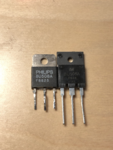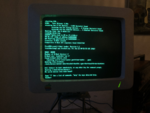horttanainen
Member level 2
- Joined
- Jul 18, 2020
- Messages
- 42
- Helped
- 0
- Reputation
- 0
- Reaction score
- 0
- Trophy points
- 6
- Location
- Helsinki, Finland
- Activity points
- 492
Hello @Relayer ,
The voltages measured:
Pin 1 measured 125.4V
Pin 2 measured 25.8V
Pin 3 measured 15.8V
Pin 4 is ground.
What I gather is that the loads on 26 volt and 16 volt rails pull the voltage down 0.2 volts which seems healthy.
Thank you as always,
Horttanainen
There is a four wire connector on the PSU board. It has pins labeled from 1 to 4. On the schematics there are labeled lines (1M2, 2M2, and 3M2) coming from PSU from places like the cathode of D141, D142, and D143. These *M2 labels indicate the pin on the four wire connector socket on the PSU board.By the way, where are you getting these pin designations from???
I did as you asked, but instead of desoldering S492 I cut the wire between S494 and D141.Here's what you must do:
Make sure the PSU is attached to the monitor.
Disconnect one end of S494 (yes, you read correctly) and place the 240V bulb/s in as the dummy load for
the 126V rail on the cathode of D141. As I remember, you had two 240V bulbs. They should be in parallel with
each other when using them.
The voltages measured:
Pin 1 measured 125.4V
Pin 2 measured 25.8V
Pin 3 measured 15.8V
Pin 4 is ground.
What I gather is that the loads on 26 volt and 16 volt rails pull the voltage down 0.2 volts which seems healthy.
It seems that the fault lies in the 126 volt rail.At some point in your measurements you should see at least two voltages that should be correct. When that
hapends, then the fault will lie in the rail with the light bulb/s being used as a dummy load.
Thank you as always,
Horttanainen

